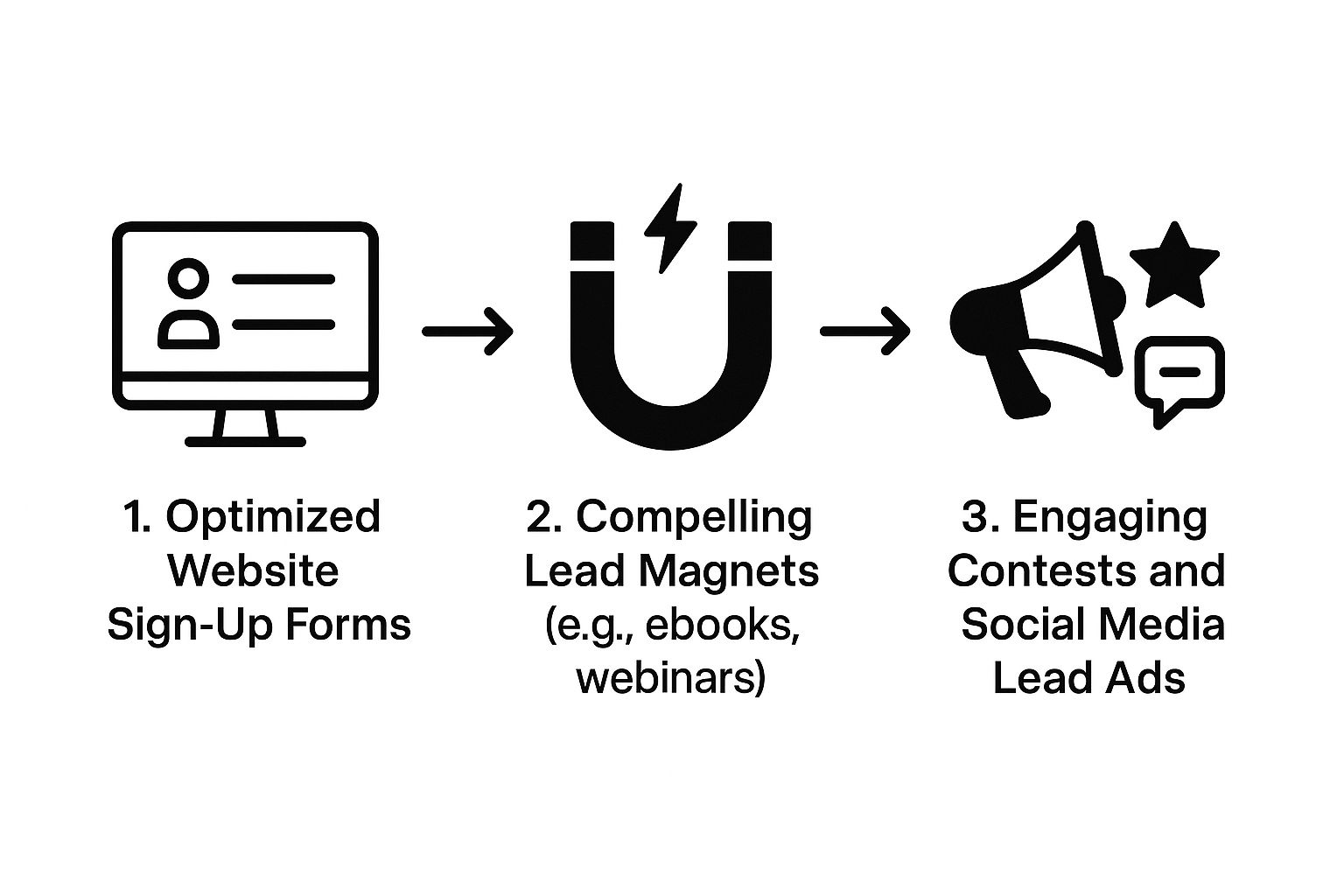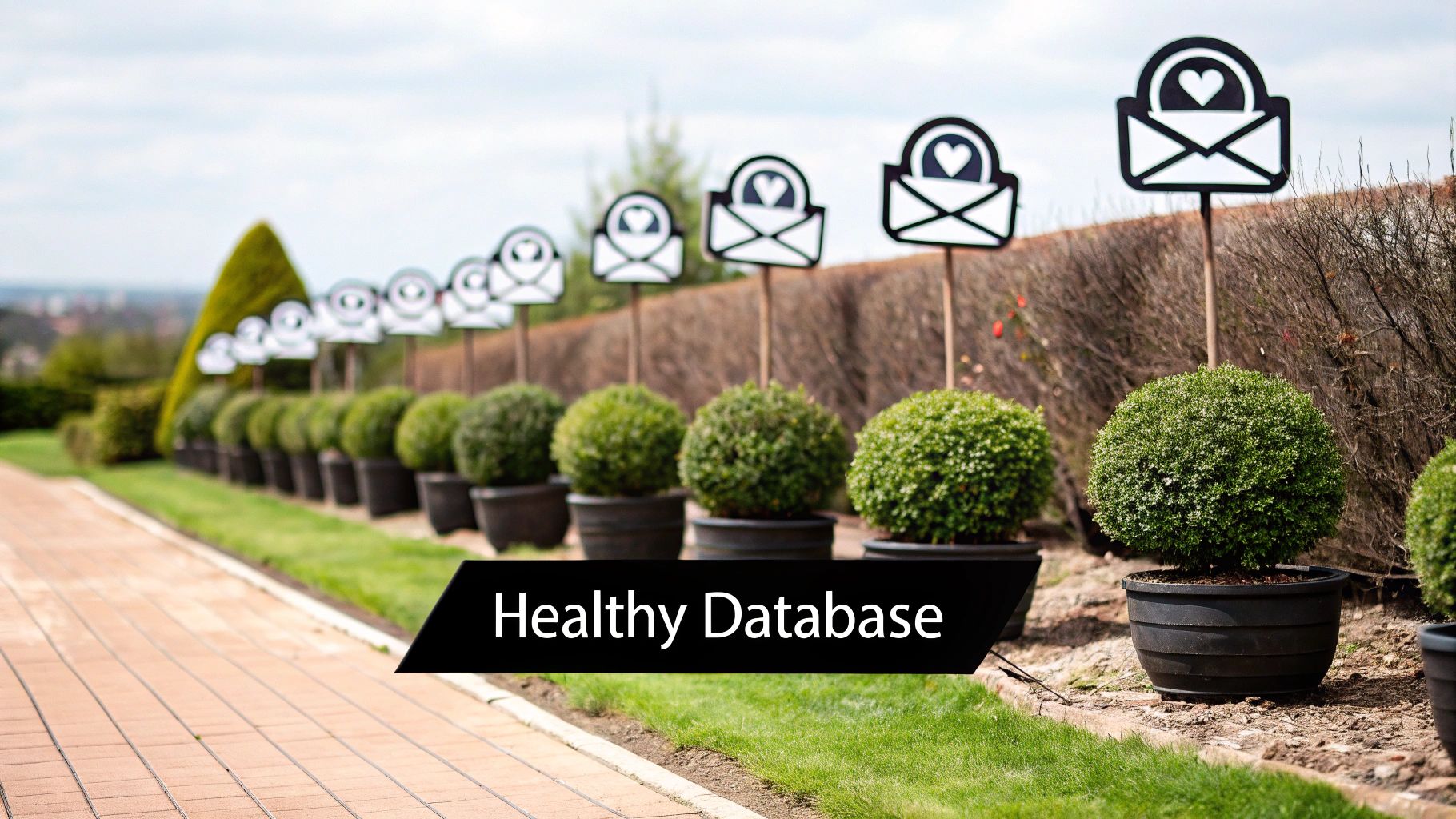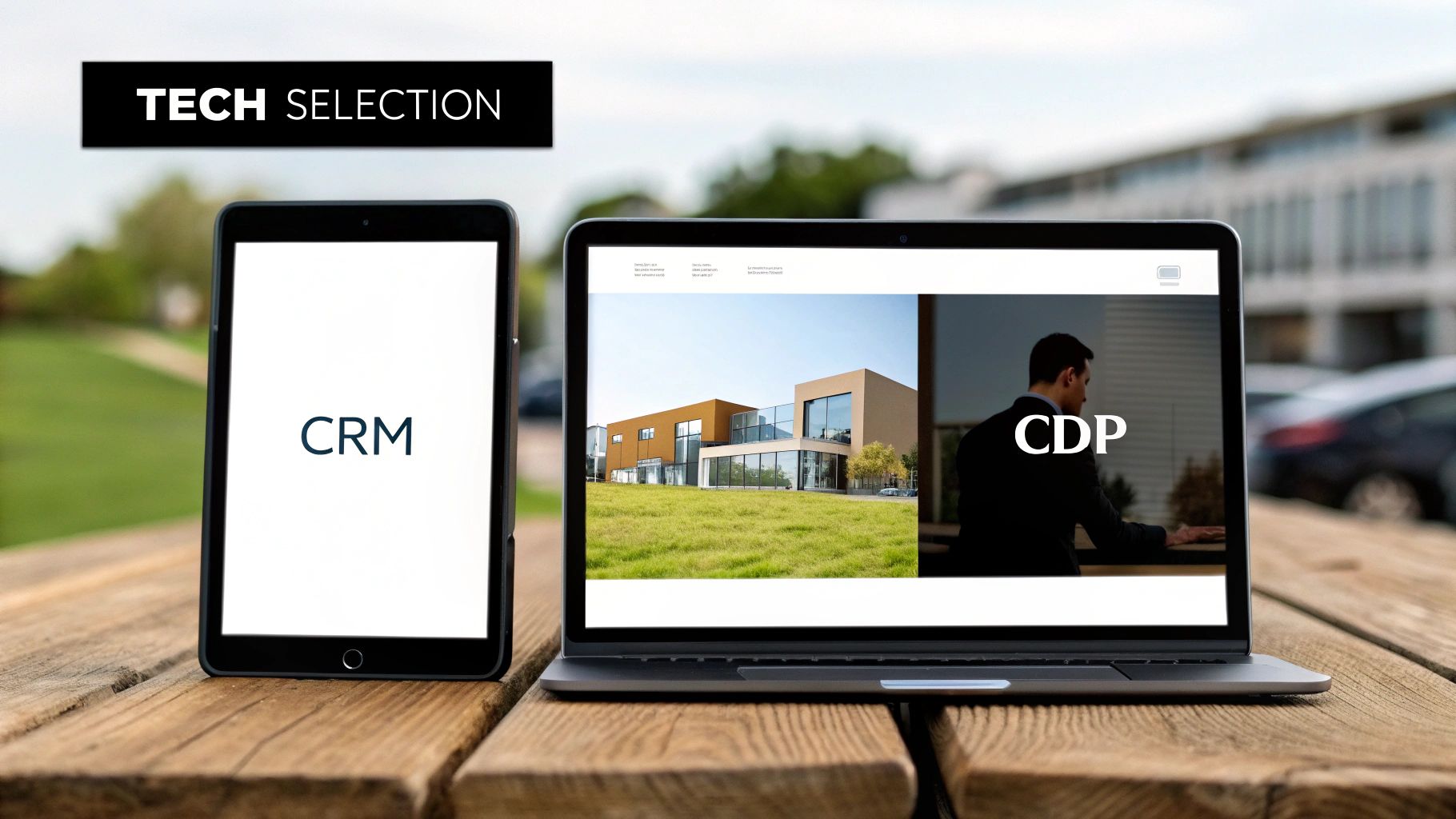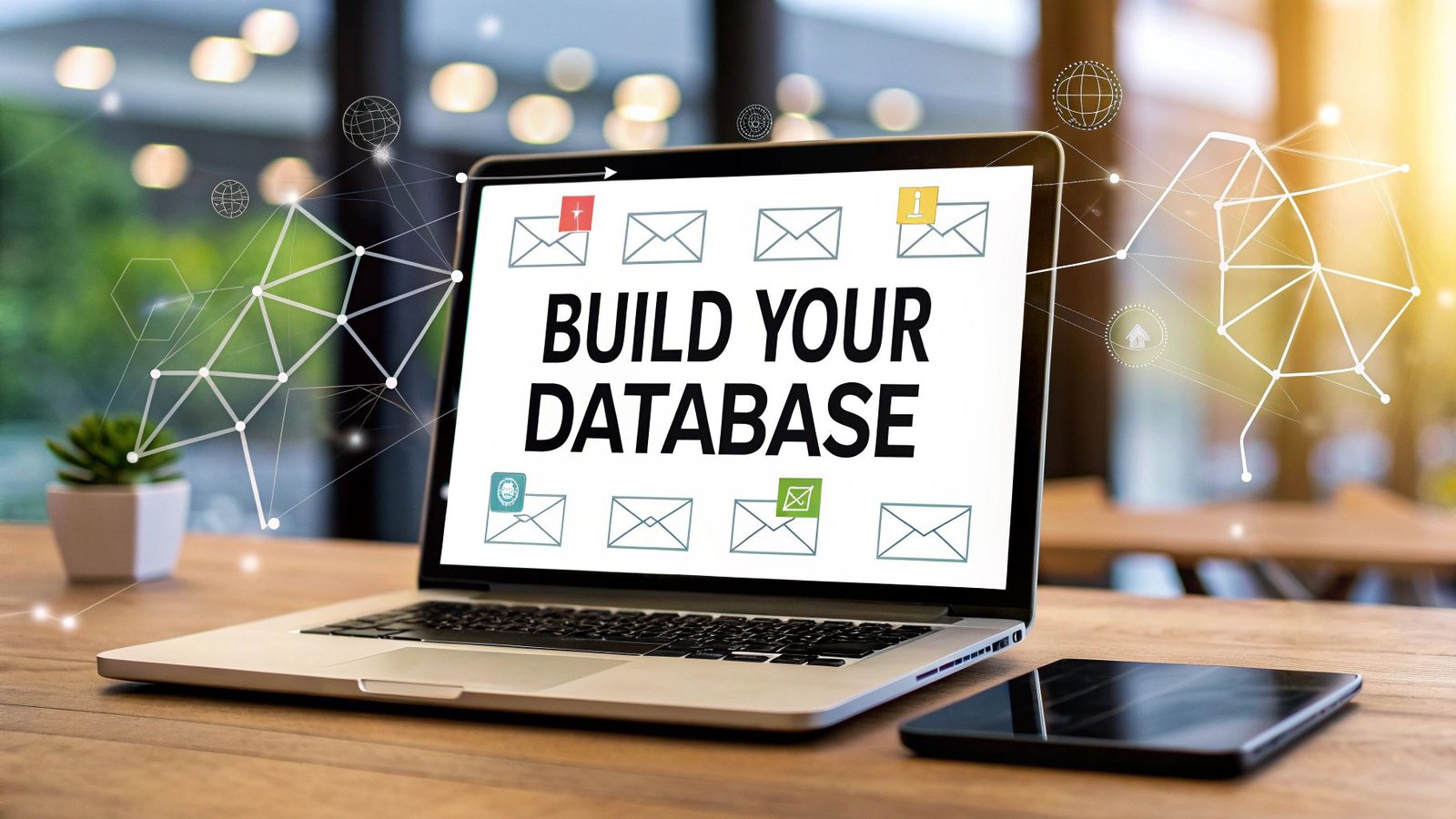Let’s be honest, calling your email marketing database a “contact list” is like calling a smartphone a "pocket calculator." It dramatically undersells what it really is. A true database for email marketing is the command center for your entire communication strategy—a living, breathing system that holds the key to turning anonymous visitors into your biggest fans.
Your Email Database Is More Than Just a List

It's a common mistake to think of an email list as just a digital rolodex. That kind of thinking keeps you stuck in the past. Your database is a powerful strategic asset, the place where you track the entire journey from a curious browser to a loyal, paying customer.
Think of it this way: walking into a crowded room and shouting a generic message is a shot in the dark. But what if you knew everyone's name, what they cared about, and what you’d talked about before? You could have real, meaningful conversations. That’s the leap from a simple list to a dynamic database.
The Shift from Quantity to Quality
Back in the day, the name of the game was list size. The more email addresses you had, the better. But that spray-and-pray approach just doesn't work anymore. In fact, a bloated list of people who don't care about your brand can actively hurt you.
Why? Because when your emails are met with low open rates and high bounces, email providers like Gmail and Outlook take notice. Their algorithms start to see you as a potential spammer, which hurts your sender reputation and can land your messages in the junk folder—even for the people who do want to hear from you.
A smaller, highly engaged database will always outperform a massive, dormant one. The goal is not just to collect emails, but to build a community of subscribers who are genuinely interested in what you have to say.
When you focus on building a quality list—people who have clearly opted in and are interested in your brand—you start seeing real results:
- Improved Deliverability: A clean, engaged list means fewer bounces and spam complaints. Your emails actually make it to the inbox.
- Higher Engagement Rates: When you send things people actually want to read, your open and click-through rates naturally climb.
- Increased Conversion Rates: It's simple—people who are interested are far more likely to buy something, download your guide, or sign up for an event.
- Stronger Brand Loyalty: Personal, relevant communication makes people feel seen, not just marketed to. That’s how you build a real connection.
The table below breaks down the key data points that elevate a simple contact list into a strategic powerhouse for any marketing team.
Table: Core Components of a Modern Email Database
| Data Component | Description | Marketing Application |
|---|---|---|
| Contact Information | The basics: email address, name, and maybe a phone number. | Essential for direct communication and basic personalization (e.g., "Hi, Sarah"). |
| Demographic Data | Information like age, gender, location, job title, or company size. | Allows for broad segmentation to send geographically or professionally relevant content. |
| Behavioral Data | Tracks user actions: pages visited, links clicked, past purchases, cart abandonment. | Powers hyper-personalized campaigns, like sending a discount for a previously viewed item. |
| Engagement History | Records open rates, click-through rates, and unsubscribes for each contact. | Helps identify your most active (and inactive) subscribers for list cleaning and re-engagement campaigns. |
| Opt-in Source | Notes where the subscriber signed up (e.g., blog post, webinar registration, checkout). | Provides context for their interests, enabling you to tailor future messages to their original intent. |
By collecting and organizing these different types of information, you're not just storing contacts; you're building a detailed picture of each subscriber that you can use to create truly effective campaigns.
Understanding the Modern Email Landscape
The need for a quality database is only growing. The number of global email users is set to reach 4.6 billion in 2025, with more than 375 billion emails flying around every single day. Cutting through that noise is a huge challenge.
This is where your database gives you an edge. Marketers who use segmentation—breaking down their database by demographics or behavior—report 30% more opens and 50% more click-throughs than those sending generic blasts. You can find more details in these email marketing statistics and see how they impact strategy. The message is clear: success today isn’t about shouting the loudest; it's about having targeted conversations, and that all starts with a smart, well-managed database.
Building Your Database from the Ground Up
A truly powerful email marketing database isn't something you can buy off the shelf. It's built, one genuinely interested subscriber at a time. The whole game is rooted in a simple value exchange: offer something worthwhile, and people will gladly give you their email address in return. This approach is the foundation for building an audience that isn't just big, but actually engaged and ready to listen.
Your own website is the most natural place to start. Think of every page as a potential handshake, an opportunity to invite a visitor to join your community. Don't just stick a single sign-up form in the footer and hope for the best. Be proactive. Place clear, compelling calls-to-action in your blog sidebar, at the end of articles, and maybe even as a pop-up once someone has spent some time on your site.
Mastering Organic List Growth
With your website ready to capture leads, it's time to create the bait. We call these lead magnets—irresistible incentives you offer for free in exchange for an email. The secret is to offer something that solves a real, specific problem for your ideal customer.
Here are a few tried-and-true strategies that just plain work:
- Valuable Content Offers: Put together high-quality ebooks, whitepapers, or checklists that deliver actionable advice. For example, a B2B software company could create a guide on "10 Cost-Saving Strategies for Project Management."
- Webinars and Workshops: Hosting a live or on-demand online event is a fantastic way to capture emails while also positioning your brand as a go-to expert in your field.
- Engaging Quizzes or Tools: People love interactive content. A fun "What's Your Marketing Style?" quiz or a free ROI calculator can capture leads in a way that doesn't even feel like a transaction.
- Contests and Giveaways: A classic for a reason. Running a contest where an email address is the entry ticket can generate a lot of buzz and rapid list growth. Just make sure the prize is something your target audience would actually want.
The infographic below shows how these strategies flow together, starting with your website and moving into more dynamic engagement tactics.

As you can see, each step builds on the last. The result is a sustainable engine for attracting high-quality subscribers who are genuinely curious about what you have to say.
The Critical Mistake of Buying Email Lists
When you're starting out, the temptation to take a shortcut is real. The idea of instantly adding thousands of contacts to your list sounds amazing, right? But buying an email list is one of the single most destructive things you can do to your marketing efforts. It's a strategy that almost always backfires, causing serious, long-term damage.
For starters, these lists are filled with junk. You'll find outdated addresses, fake emails, and people who have zero interest in your business. When you send a campaign to a list like this, you get an incredibly high bounce rate, which is a massive red flag for email providers like Gmail and Outlook. This tanks your sender reputation overnight, making it more likely that all your future emails—even the ones to your legitimate fans—end up in the spam folder.
Purchased lists are a one-way ticket to the spam folder. The people on them never asked to hear from you, which means they're far more likely to report you as spam. Every one of those reports hammers another nail in your sender reputation's coffin.
Beyond the technical nightmare, you're wading into dangerous legal and reputational waters. Laws like GDPR in Europe and the CAN-SPAM Act in the U.S. have strict rules about consent. Blasting emails to people who never opted in can lead to hefty fines. But even worse, you're poisoning your brand. You destroy trust before you ever have a chance to build it, immediately marking your company as one that sends annoying, intrusive junk.
If you want to build a list the right way, it's worth exploring how to get a mailing list through ethical and effective methods that actually work.
How to Keep Your Email Database Healthy

Think of your database for email marketing as a well-tended garden. If you let it get overrun with weeds and pests, the whole thing starts to wither. The same goes for your subscriber list—without regular care, it gets clogged with bad data, choking your ability to connect with the people who actually want to hear from you.
This ongoing "weeding" process is what we call data hygiene. It's all about systematically cleaning and updating your database to keep it accurate, engaged, and effective. A smaller, focused list of active subscribers will always outperform a massive, dormant one. Why? Because it leads to better deliverability and engagement metrics that mean something.
The Problem of Inactive Subscribers
So, what do you do with subscribers who haven't left but have just gone silent? These are your inactive contacts—the folks who haven't opened or clicked an email in, say, three to six months. Before you just delete them, a re-engagement campaign is your best bet to win them back.
A re-engagement or "win-back" campaign is a targeted series of emails designed to remind people why they signed up in the first place and give them a reason to interact again.
Here are a few proven approaches:
- The "We Miss You" Offer: Send a friendly email with a special discount or a piece of exclusive content. Frame it as a small thank-you for being part of your community.
- The Preference Update: Simply ask them to update their email preferences. This puts them back in control and gives you valuable data for better segmentation down the road.
- The Last Chance Warning: If they still don't bite, send one last email letting them know you'll be removing them from the list unless they click to stay. It’s a clean, direct way to confirm they're no longer interested.
For organizations that depend on community engagement, like nonprofits, database health is a huge deal. Studies reveal that while 86% of nonprofits use email marketing, their lists decay fast—about 7% of contacts become undeliverable and another 9% unsubscribe each year. Yet, only 35% of these groups make a habit of removing unengaged subscribers. This points to a massive opportunity to improve data hygiene and, ultimately, campaign results. You can learn more about how to fix these issues by reading about common data quality problems.
Email Database Maintenance Checklist
Regular maintenance stops small issues from spiraling into big problems. By building these tasks into your routine, you protect your sender reputation and make sure your emails actually land where they're supposed to: the inbox.
Here’s a simple checklist to keep your email list in top shape.
| Task | Frequency | Impact on Performance |
|---|---|---|
| Correct Typos & Obvious Errors | Monthly | Prevents unnecessary bounces from simple mistakes like "gnail.com". |
| Remove Hard Bounces | Immediately (Automated) | Protects sender reputation by removing invalid addresses instantly. |
| Monitor & Remove Repeat Soft Bounces | Monthly / Quarterly | Cleans out temporarily unavailable addresses that have become permanent problems. |
| Process Unsubscribes | Immediately (Automated) | Essential for compliance (CAN-SPAM, GDPR) and maintaining trust. |
| Run a Re-Engagement Campaign | Quarterly / Biannually | Wins back disengaged subscribers and identifies those who should be removed. |
| Segment Your List | Ongoing | Boosts engagement by ensuring content is relevant to specific audience groups. |
Following a consistent schedule for list hygiene isn't just about cleaning up—it's about maximizing the potential of every single email you send. A healthy list is a powerful asset.
The health of your email database directly impacts your sender reputation. High bounce rates and spam complaints signal to email providers like Gmail that you are a low-quality sender, making it more likely your future campaigns will land in the junk folder.
Using AI and Automation to Manage Your Database
Not so long ago, managing an database for email marketing was a grind. It meant endless hours of manual data entry, painstakingly sorting lists, and making a lot of educated guesses. Thankfully, those days are over. Technology has turned this chore into a genuine strategic advantage, with AI and automation tools transforming your static contact list into a dynamic asset that practically optimizes itself.
Think of AI as the sharpest assistant you've ever had—one who knows your audience on a level you could never achieve on your own. Instead of just segmenting people based on what they did buy, AI can predict their future behavior. It can automatically group together subscribers who are likely to buy a specific product or click on a certain topic.
This fundamentally shifts your entire approach from reactive to proactive. You get to anticipate what your customers need, sometimes even before they realize it themselves. For the subscriber, it creates a level of personalization that feels uncanny and incredibly relevant.
Intelligent Segmentation and Personalization
Manual segmentation is a great start, but it has its limits. AI-powered segmentation completely shatters those limits. It can crunch thousands of data points in the blink of an eye—everything from browsing history and click patterns to the amount of time someone spent staring at a product page.
AI finds the subtle connections that a human marketer would almost certainly miss, creating hyper-targeted audience segments as things happen. For example, an AI could instantly pull together a group of:
- Subscribers at risk of churning: It can spot the subtle signs of disengagement—like a slight drop-off in opens—and flag these users. This gives you the chance to launch a targeted re-engagement campaign before you lose them for good.
- Users with high purchase intent: By analyzing on-site behavior, the AI can pinpoint who’s ready to pull the trigger and automatically send them an email with a perfectly timed offer.
- Predictive demographic groups: It can infer interests and preferences based on early behavior, helping you tailor content even for new subscribers you don’t know much about yet.
AI and automation aren't just buzzwords anymore; they're essential tools for any serious marketer. They handle the heavy lifting of data analysis, freeing you up to focus on what people do best: big-picture strategy and creative thinking.
The proof is in the numbers. The adoption of this technology is widespread, with 87% of organizations now using AI to get more from their email marketing. And it delivers real results. AI-driven campaigns are seeing a 41% increase in revenue and a 13.44% boost in click-through rates. You can dig deeper into these trends with these email marketing statistics.
Optimizing Every Aspect of Your Campaigns
Beyond smarter segmentation, AI and automation are quietly improving just about every other part of the email marketing workflow. They work behind the scenes, fine-tuning the little details that add up to a massive impact.
One of the most powerful examples is send-time optimization. Forget the old "send it at 10 AM on Tuesday" approach. AI looks at each subscriber's personal open history and delivers the email at the exact moment they are most likely to be checking their inbox. The impact on open rates can be huge.
Here are a few other game-changing functions:
- Generative AI for Copywriting: Modern AI tools can help you brainstorm and draft subject lines, email copy, and calls-to-action. Some can even personalize the copy on the fly, adjusting the tone or offer for different audience segments.
- Predictive Analytics: AI algorithms can forecast how a campaign is likely to perform. This helps you put your budget and effort where they’ll have the biggest impact and identify winning strategies ahead of time.
- Automated List Hygiene: Instead of manually scrubbing your list, AI can automatically spot and flag invalid or risky email addresses. This keeps your database clean and protects your sender reputation without all the tedious work.
When you bring these tools into your process, you’re no longer just managing a list of contacts. You're building an intelligent system that learns, adapts, and consistently finds new ways to improve your results.
Choosing the Right Technology for Your Database

Picking the right platform to manage your email database is a lot like choosing the right vehicle. A simple scooter gets you around town, but you wouldn't take it on a cross-country road trip. The technology you choose is the engine powering your entire email marketing strategy—it determines your reach, your speed, and your ability to navigate complex customer journeys.
This decision is about more than just picking a standard Email Service Provider (ESP). While an ESP is perfect for sending newsletters, you'll find your needs quickly evolve. As you grow, two other heavy-hitters come into play: Customer Relationship Management (CRM) systems and Customer Data Platforms (CDPs).
Comparing Your Core Options
Before you can pick a winner, you need to understand what each of these platforms is really built for. They all handle email, but their core purpose is fundamentally different. Think of them as specialized tools for different jobs.
- Email Service Provider (ESP): This is your starter kit. ESPs are built from the ground up to do one thing exceptionally well: create, send, and track email campaigns. For any business just getting its feet wet with email, this is the logical place to start.
- Customer Relationship Management (CRM): A CRM is all about managing relationships, not just sending emails. It’s your system of record for every customer interaction, from sales calls and meetings to support tickets. This gives you that coveted 360-degree view of the entire customer lifecycle. We break it all down in our guide on customer relationship management basics.
- Customer Data Platform (CDP): Think of a CDP as your data headquarters. It’s the most sophisticated option, designed to pull in customer data from every single source—your website, mobile app, CRM, payment processor, you name it. It then stitches all that information together into a single, unified profile for truly deep personalization across every channel, far beyond just email.
The right platform is the one that matches your current complexity and future ambitions. A local bakery can do amazing things with an ESP, but an e-commerce giant needs the unified data of a CDP to keep its customer experience from falling apart.
Ultimately, it comes down to matching the tool to the task. An ESP sends emails. A CRM manages relationships. A CDP unifies and activates customer data on a massive scale.
Key Criteria for Your Decision
Okay, you know the categories. So how do you actually choose a specific tool? It's time to get practical and look past the shiny marketing promises. Your decision should boil down to your team's real-world needs, your budget, and where you see your business in the next few years.
When you're comparing options, run them through this checklist:
- Integration Capabilities: How well does it play with others? The platform has to connect seamlessly with the tools you already rely on, like your website, analytics software, or payment gateway. Bad integrations mean data headaches and wasted time.
- Segmentation and Automation: This is where the magic happens. Can you create sophisticated audience segments based on real behavior, not just simple tags? Look for a system that lets you build powerful "if this, then that" automation rules that respond to what your customers actually do.
- Scalability: Will this platform grow with you, or will it hold you back? Make sure it can handle a much larger contact list and more complex campaigns down the line without the price suddenly exploding.
- Ease of Use: A tool is only as good as your team's ability to use it. An overly complicated interface will just sit there collecting dust. Find a platform that feels intuitive and lets your team get work done without needing a PhD in software engineering.
- Pricing Structure: Get crystal clear on how you'll be charged. Is it per contact, per email sent, or based on features? Do the math to understand the total cost, especially as you expect your database to grow. No one likes surprise bills.
Common Questions About Email Databases
Getting started with email databases always brings up a few key questions. Let's walk through some of the most common ones I hear from marketers, so you can feel confident managing your list.
Think of this as the practical advice you need to keep your email marketing engine running smoothly.
How Often Should I Clean My Database?
This is a big one. The best approach is to treat list cleaning as an ongoing task, not a massive project you dread once a year. While a deep clean is a good idea at least twice a year, the real magic is in continuous maintenance.
For instance, your email platform should be set up to automatically remove any hard bounces after every single send. No exceptions. On top of that, you should plan to run a re-engagement campaign for your inactive subscribers every 3-6 months. This simple routine keeps your list healthy and protects your all-important sender reputation.
Is It Ever Okay to Buy an Email List?
Let me be blunt: no. It's a shortcut that will absolutely backfire, every single time. Purchased lists are almost always a cocktail of old, inactive, or just plain fake email addresses. Sending to them causes your bounce rate to skyrocket, which is a massive red flag for providers like Gmail and can get your domain blacklisted.
Even more critical is the issue of consent. The people on that list never asked to hear from you. This is more than just bad manners; it violates anti-spam regulations like GDPR and guarantees you'll see a flood of spam complaints and unsubscribes. Building your list organically is the only way to build a real, lasting connection with an audience.
What Is the Difference Between a CRM and an Email Platform?
It’s easy to get these two confused. An email marketing platform is a specialist's tool. Its whole purpose is to send email campaigns, manage your subscribers, and run automations. Think of it as the vehicle for delivering your email strategy.
A Customer Relationship Management (CRM) system is much bigger in scope. It’s designed to be the central hub for every single interaction a customer has with your company—sales calls, support tickets, website visits, you name it. While most CRMs can send emails, their main job is to give you that complete, 360-degree view of each customer relationship.
What Are the Most Important Health Metrics to Track?
Beyond open and click rates, you need to monitor the vital signs of the database itself. These are the numbers that tell you if your list is actually healthy or just large.
- List Growth Rate: How fast are you bringing in new, genuinely interested subscribers?
- Bounce Rate: Keep a close eye on your hard bounces. These are dead-end addresses that must be removed immediately.
- Spam Complaint Rate: This is your early warning system. If this number creeps above 0.1%, you have a serious problem.
- Percentage of Active Subscribers: What portion of your list has actually opened or clicked an email in the past six months? This metric reveals the true engagement level of your audience.
At Nordic Lead Database, we provide the most extensive database of verified decision-makers and companies from the Nordics to help you build high-quality, targeted lists from the start. Find your next customer with Nordic Lead Database.
